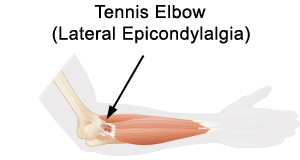Medical Library
Tennis Elbow (Lateral Epicondylalgia)

Lateral (meaning away from the midline of the body) epicondylalgia (meaning pain of the epicondyle) is a painful condition on the outer aspect of the elbow. The common name for lateral epicondylalgia is tennis elbow but only 5% of the people afflicted with this condition play tennis.
Pain at the elbow may have one or more causes: it could be from the forearm tendons that attach at the outer aspect of the elbow, it could be referred pain from the next, it could be from one or more of the joints at the elbow, or it may originate from the radial nerve that is in close proximity to the elbow joint.
It often occurs with repetitive use of the arm especially with a clenched fist. Most cases are not due to tennis.
Local tenderness and pain with resisted and passive extension of the wrists is common.
Activity modification, anti-inflammatory medications, ice, and progressive stretching and strengthening will relieve most cases. Surgery is only an option in recalcitrant cases.
Possible Treatments
- Cryotherapy or Cold Therapy Video
- Elbow Active Range of Motion Video
- Elbow Joint Mobilization Video
- Elbow Passive Range of Motion Video
- Elbow Resistive Range of Motion Video
- Electrotherapeutic Modalities
- Foam Roll Exercise Video
- Isometric Exercise Video
- Iontophoresis
- Physical Agents
- Soft Tissue Mobilization Video
- Stretching/Flexibility Exercise Video
- Cryotherapy or Cold Therapy
Possible Treatment Goals
- Decrease Risk of Reoccurrence
- Improve Fitness
- Improve Function
- Improve Muscle Strength and Power
- Increase Oxygen to Tissues
- Improve Range of Motion
- Improve Relaxation
- Self-care of Symptoms
- Improve Tolerance for Prolonged Activities
Additional Resources
Disclaimer
The information in this medical library is intended for informational and educational purposes only and in no way should be taken to be the provision or practice of physical therapy, medical, or professional healthcare advice or services. The information should not be considered complete or exhaustive and should not be used for diagnostic or treatment purposes without first consulting with your physical therapist, occupational therapist, physician or other healthcare provider. The owners of this website accept no responsibility for the misuse of information contained within this website.
